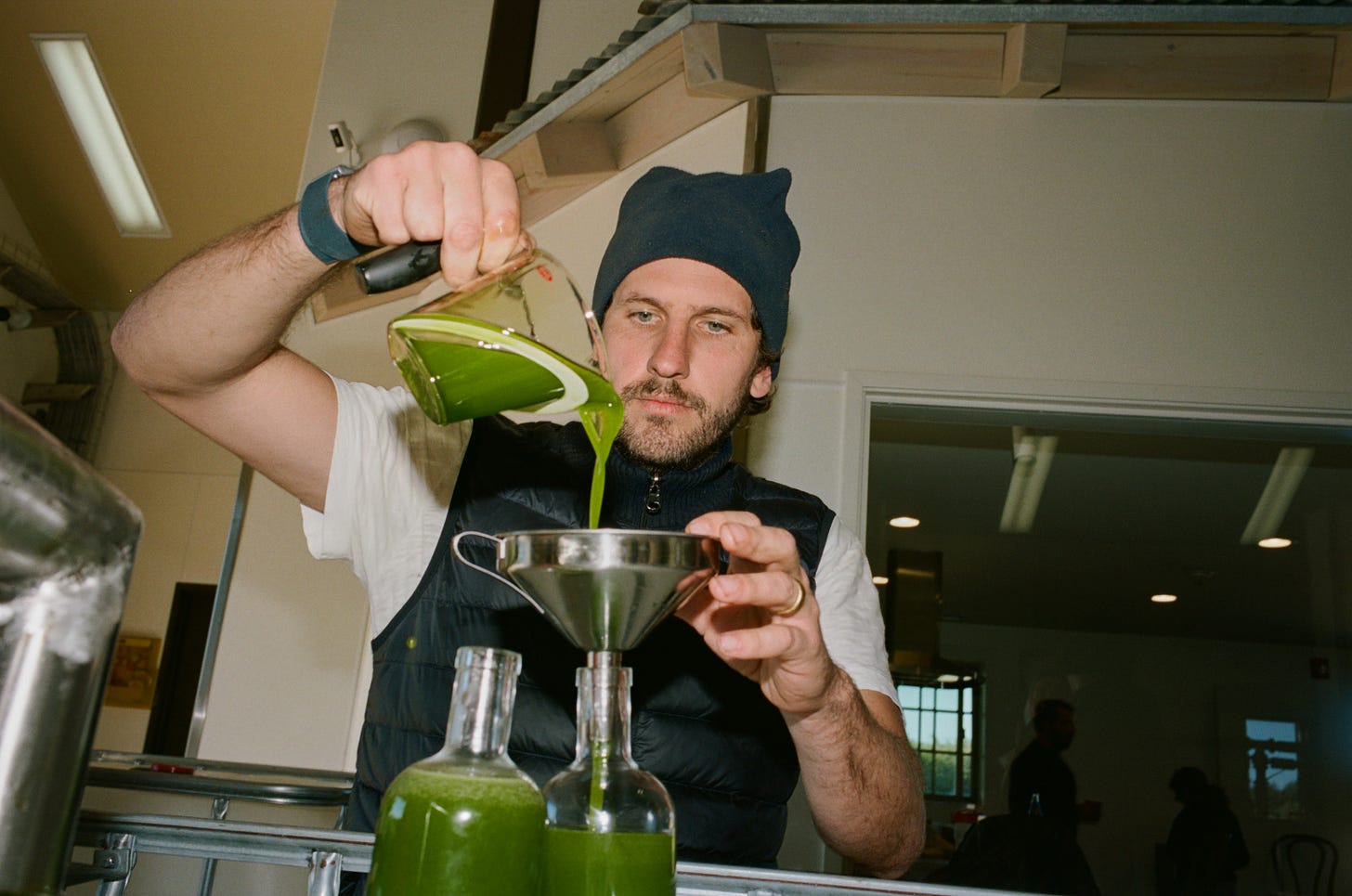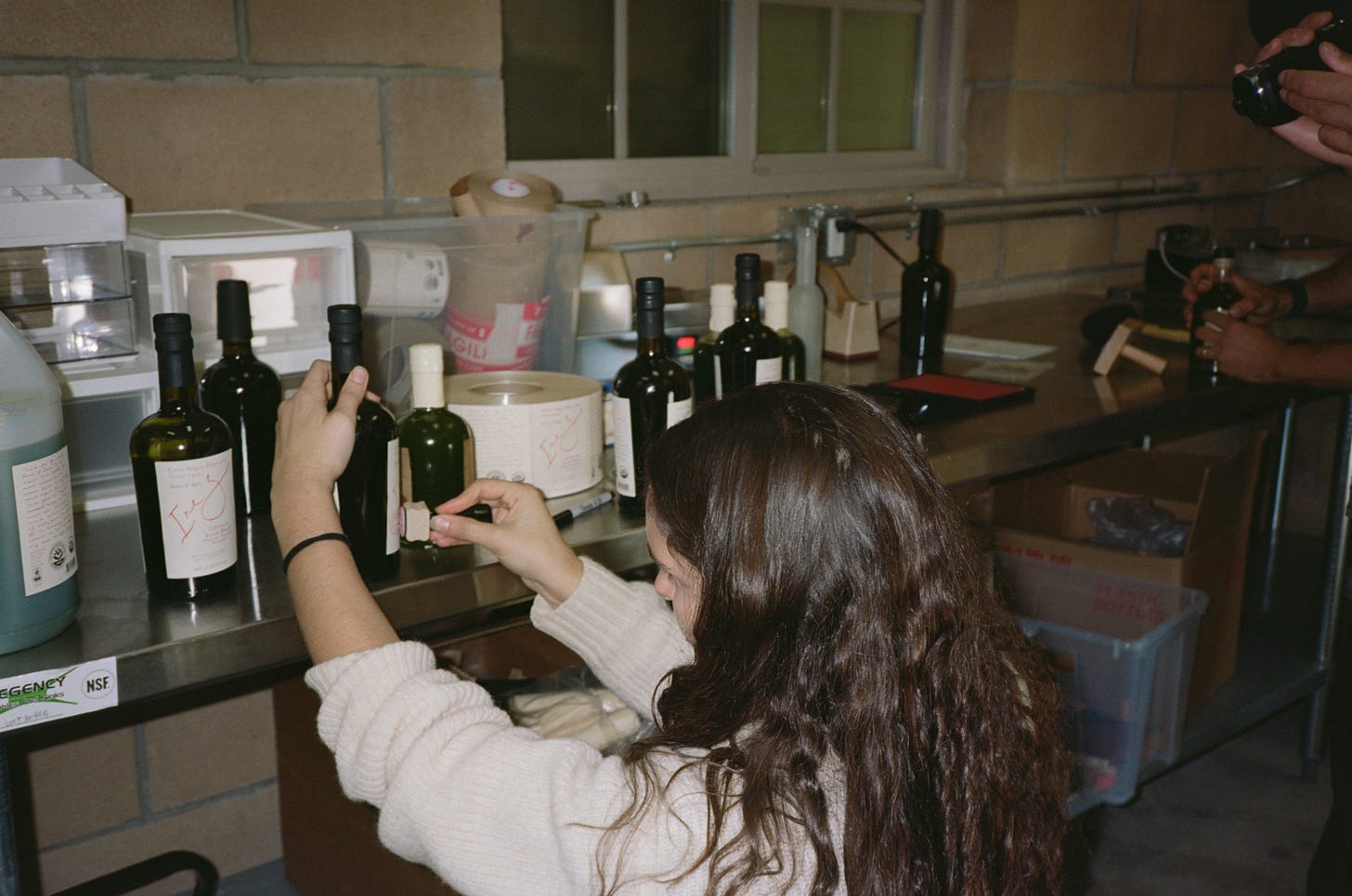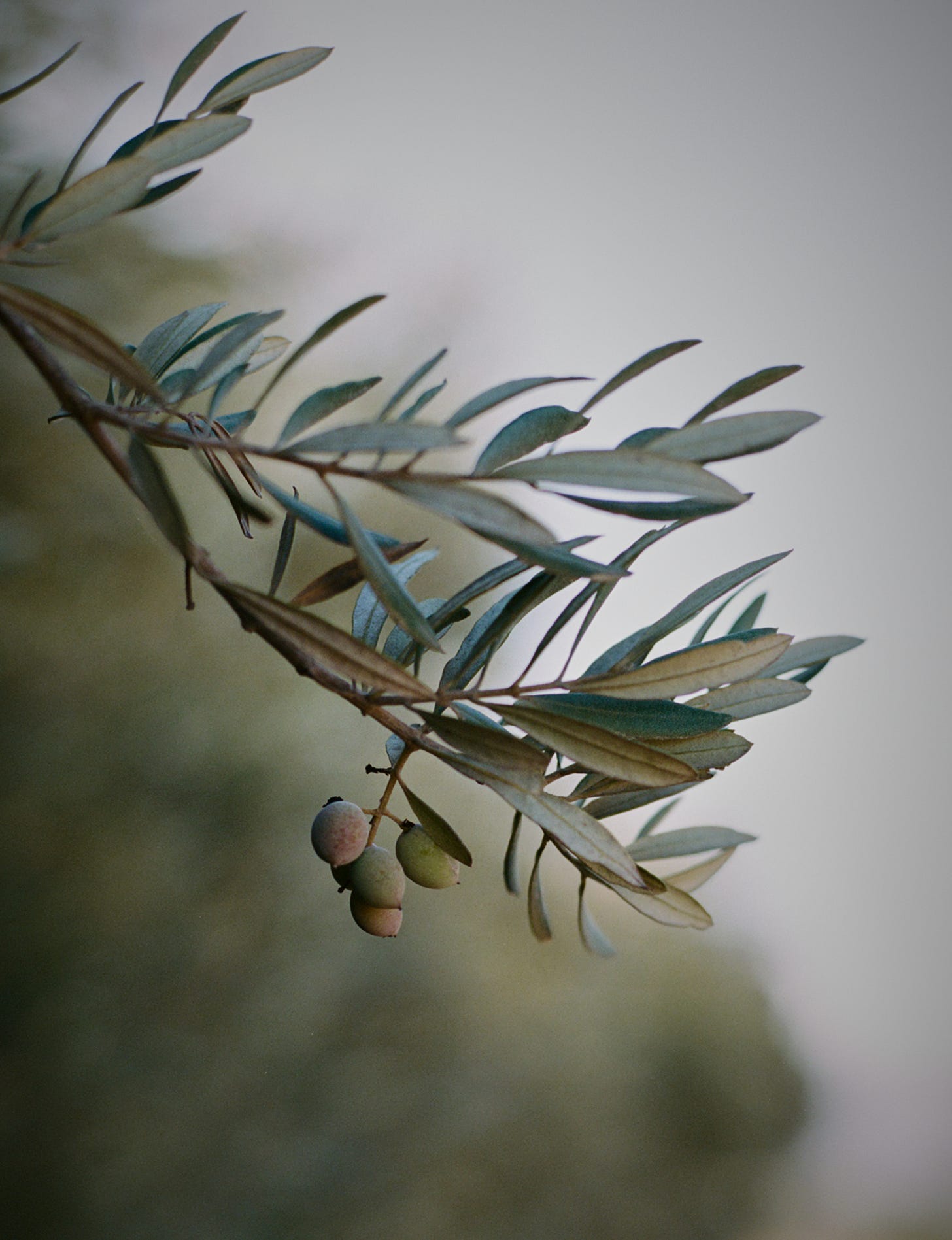Introducing Inez, Incredible Olive Oil Made by a Family of Five in Santa Ynez
From their organic farm and mill in the Santa Barabara wine country, the Zimmermans are crafting what’s bound to be California’s next breakout olive oil brand.
Photographs by David Gurzhiev
It’s harvest season for olive oil. In the Northern Hemisphere, that is. Along with the dominant olive oil-producing countries of Spain, Italy, and Greece, olive trees in California are harvested from October through January. At Inez Olive Oil, a family-run organic farm and mill in the winemaking region of Santa Ynez, 120 miles northwest of Los Angeles, they’re currently harvesting 36 acres of Arbequina, Arbosana, and Koroneiki crops—two Spanish cultivars and one Greek—amidst shimmying pink peppercorn trees, yellowed Aspens, fruit-laden pomegranate and apple trees, and weather-beaten figs.
Then, they’re pressing olives into olio nuovo, the first and freshest oil of the season. As the day’s first round of olives is crushed into a paste and transformed into extra-virgin olive oil, a potent wheatgrass aroma fills the mill. Within an hour, a cloudy, glowy, golden-green liquid begins to flow out of a stainless steel pipe and into a tank, its silky body cascading in a thick, ribbony stream. Knock back a shot of it, and your palate will be coated with fruit and grass, followed by a pungent, peppery finish that lingers in your glands, causing a coughing sensation as a simultaneous smile spreads across your face. In other words, this is the good stuff.
Inez’s Olio Nuovo, along with their California Estate Blend, each comprised of a unique ratio of all three varietals, is so good you’d be surprised to learn that the family at the helm is new to this. The Zimmermans purchased the farm in early 2022, a few years after its former owner died. Steve Zimmerman, a real estate developer, and his wife, the artist Lianne Barnes, have owned a cattle ranch less than a mile from the farm since 1993, when their first daughter, Kelly Zimmerman, was born. Kelly and her sister Katie [also Zimmerman; I’ll refer to the Zimmermans by their first names from here on] grew up between the ranch and their other family home in Topanga. Last year—on the ranch, naturally—Kelly married the screenwriter Augustin Vita.
“The opportunity presented itself to go look at this property, and we were like, ‘Do we do this?’” recalls Kelly. “Something came over us, and we decided to go for it. We have experience raising cattle and growing grapes, so it wasn’t our first time getting into ag[riculture], but it was our first time pursuing it as a family.” Vita, whose dad is an avid gardener and whose grandfather was a fruit and vegetable wholesaler in the Bronx, was equally inclined to embark on the project. Perhaps most notably, olive oil has played an important role in the Zimmermans’ pantry, more so than the average household. “My dad has been a long-time seed oil hater for 20 years. He makes us call restaurants to see if they use pure olive oil only,” adds Kelly, laughing. Since she and Katie were kids, Steve has advocated for the health benefits of high-quality, extra-virgin olive oils that are high in polyphenols and fatty acids and have been proven to reduce inflammation, promote heart health, and prevent cancer. He uses olive oil in his hair and as sunscreen and harbors a collection of olive oils from his favorite vineyards around the world. For the family, purchasing the farm “just fully made sense,” says Katie, who, well before she became an owner of an olive oil farm, was putting olive oil in her coffee and on her pancakes.
Luckily, the property was already set up to yield a high-quality product. It’s functioned as an olive oil farm for at least 15 years since the former owner converted it from a thoroughbred horse farm by planting olive trees and installing a mill, enabling oil to be pressed on-site within an hour from harvesting. “They set it up in such a way that made it very easy for us,” says Vita. “We didn’t have to buy any equipment. The mill was there. José Rubio, [our ranch manager], has been living on the property since the year 2000.” Still, he and the rest of the family knew little about farming olives or producing olive oil. So they read up and started leaning on local grape farmers for answers to questions about soil and machinery. The key, however, to unlocking the knowledge they needed was Scott Sanders, an Australian mill master who had worked on the property in the past. Vita spent a year trying to track him down.

Sanders, who runs an olive oil supplier in Victoria, Australia called Oasis Olives (which supports the Australian brands Goldi and Mount Zero), spends his offseason in California, consulting on olive oil farms. (In the Southern Hemisphere, the olive oil harvest starts in April and ends in June.) “I left Scott like five voicemails, and then we finally got him on a Zoom call,” recalls Vita. “Fortunately, he was coming out here for the season anyways to consult on other farms, so he came by, and we all hit it off.” Soon after Sanders came on board, so did David Olander, a sales broker with 30 years of wholesale experience working for companies like Kraft Foods and California Olive Ranch.
In the first year of Inez, 2022, they lost their harvest because of a frost that jeopardized crops across the entire valley, which served as a crash course in the realities of farming produce. By 2023, they were up and running, producing olive oil and selling it wholesale, filling gallons instead of glass bottles. Daisy Ryan, the acclaimed chef of Bell’s in nearby Los Alamos, was an important early adopter. “I would say I probably use olive oil more than anything else in the restaurant. We bathe in it, basically,” she says. “When Inez brought me a sample, I was like, ‘Thank god.’ Not to say that there aren't other really lovely olive oils being made here, but there was just something about it. You could tell the care, the quality.” At Bell’s, she finishes salads and ice creams with Inez Olive Oil and uses it with cheeses and vegetables. Right now, kabocha squash with anchovies and Inez Olive Oil is on the menu—and because the brand is listed by name, guests are already asking where they can buy some.
Today, as their second harvest is underway, Inez is supplying gallons of oil to Tyler Wells of All Time and Bernee, he and his wife Ashley’s soon-to-be second restaurant in Altadena, in addition to the bustling all-day café Leora, inside the headquarters of United Talent Agency in Beverly Hills. Stir Crazy, the elegant wine-focused restaurant on Melrose, is in on Inez too—last week on Instagram, they captured the luminous green Olio Nuovo being drizzled onto crudo at the pass. And in New York, bottles of last year’s California Estate Blend are up for grabs on the shelves of Flynn McGarry’s new shop, Gem Home. The Los Angeles-born chef also cooks with Inez for the café portion of the shop. By next month, Inez Olive Oil will start to appear in boutique grocers across L.A. and beyond. (Specifically, this year’s Olio Nuovo and last year’s California Estate Blend.)
Initially, they were planning to focus on wholesale, with the added benefits of having a personal stash and being able to gift bottles to friends and family. However, as they learned the ropes of making olive oil and continued to taste and use their oil, their pride in the product inspired a brand. “One of the biggest things that the ranch has going for it is it’s quite a small ranch, so it's very easy to control all the inputs and gain quality product,” says Sanders. “And [the family] also controls all the processes. They own the ranch, they own their harvester, they own their mill, and they own their own olive oil label, so they have full control over every input.” At only 60 acres, Inez Olive Oil is the smallest property Sanders works with (the largest is 8,000 acres).
For olive oil to be considered extra virgin, it has to be pressed within 24 hours of being picked. At Inez, they’re pressing within an hour while the olives are still green, contributing to higher polyphenol and fatty acid counts in the final product. As Sanders explains, “When the olives are attached to the tree, the oil is protected inside a cell or a sack, so the olive oil doesn’t come into contact with any other part of the olive. Once you take the olive off the tree, those cells start to break down, and the oil starts to come into contact with the vegetable water, the olive pit, and the flesh, and that starts to degrade the oil. So as quickly as you can get it off the tree and turn it into oil, the better quality the product will be. They’re there within two hours from harvest to oil; there’s no commercial supplier that can offer that turnaround time.”
Most olive oil brands on the market don’t own their farms. Instead, they buy from other growers, often from multiple different farms. Inez, comparatively, makes single-source olive oil, another distinction of high quality. Furthermore, the labels stamped onto each bottle of Inez Olive Oil include the harvest date for transparency. “We don’t want to take away from other brands, we’re not interested in doing that, but inherently, by running and operating our farm, there are things that we can point to that other people can’t,” says Vita. They’re also grateful to be following in the footsteps of Graza, a popular brand that has made inroads to educate consumers about the health benefits of olive oil.
This level of quality lends itself to a higher price point. McGarry sells bottles of Inez’s California Estate Blend for $42, while the Olio Nuovo will hover around $50 on shelves. Certain people might categorize Inez as a finishing oil, something to drizzle on top of complete dishes or reserve for special occasions—and yet it’s sold in 500-milliliter bottles, not as a fancy 200-milliliter pantry item. In the Zimmerman household, Inez is used in everything, from dressings to fish, meat, and vegetables. They even dip their steak in it, like ketchup. “It has flavor to it; it’s not a neutral oil. It’s going to impart flavor into your dish,” says Kelly.

The harvest will wrap up by the end of the year at the Inez Olive Oil farm. Then, the settling process will last through winter—specifically, racking, the most organic and delicate way to remove sediment from olive oil. At the same time, trees will be sprayed with natural copper, fertilizers, and organic seaweed. Ground cover, mostly pea tendrils, will be planted. Nitrogen will be added to the soil. By spring, the 2024 California Estate Blend will be bottled, labeled, and shipped. That’s also when the new growth begins.
While Vita and Kelly oversee the day-to-day operations at the farm, and Katie handles social media, Inez is a true family business. You might find Steve picking out sticks from the pile of harvested olives before they’re pressed into paste or Barnes labeling and packing boxes well into the night. “Whoever can go to UPS that day or FedEx goes out and handles it,” says Kelly. Working as a unit comes with challenges, but the close-knit family has found it natural to collaborate. “We do speak the same language, and we understand what each other wants individually,” says Katie. “If I can’t get an idea across perfectly, somehow my sister can articulate it for me, and vice versa.”
They’re gearing up to sell directly to consumers any day now. Down the line, they hope to add beehives to make honey, bottle vinaigrettes, and host dinners on the farm. Katie is particularly excited about the prospect of producing olive oil-based scents and skincare products. “We’re just trying to scale it in a way that keeps it fun,” says Vita. “It’s like, ‘Wait, why did we do this?’ Because we love the land.”













